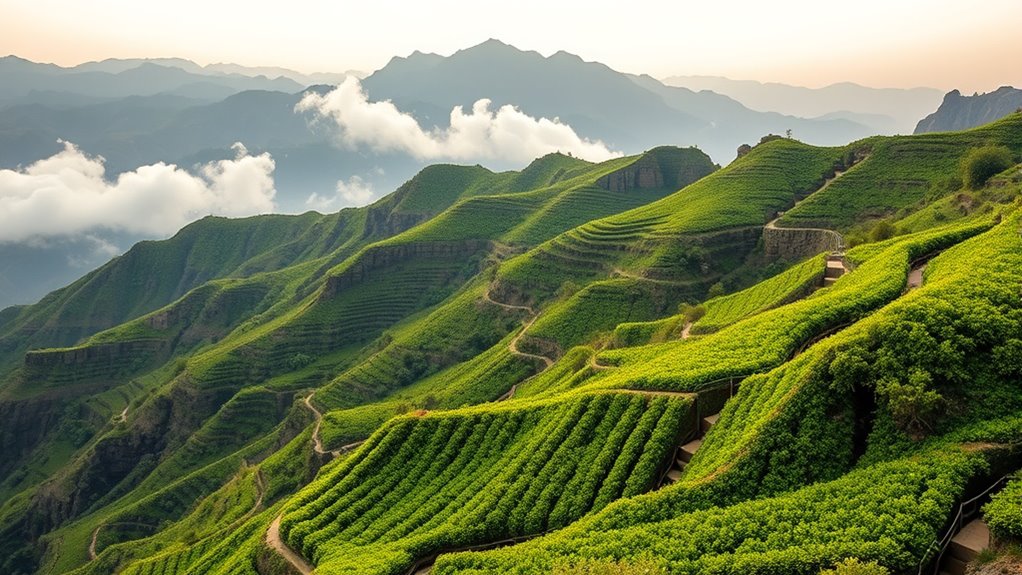Coffee’s journey from Ethiopia to Arabia begins in Ethiopia’s highlands, where legend credits Kaldi’s goats with discovering the energizing berries. Ethiopian monks used coffee in spiritual rituals, shaping its cultural role. Through trade routes across the Red Sea, coffee traveled to Yemen’s mountains, where it was cultivated and traded at ports like Mocha. This movement laid the foundation for Arab coffee culture, shaping social life and spiritual practices that continue today. Explore further to uncover the fascinating changes along this historic path.
Key Takeaways
- Coffee originated in Ethiopia, where goats and monks discovered its stimulating effects, integrating it into spiritual and social rituals.
- By the 15th century, trade routes across the Red Sea facilitated coffee’s migration from Ethiopia to Yemen.
- Yemeni traders transported coffee beans and plants, establishing cultivation in Yemen’s volcanic highlands and port cities like Mocha.
- Yemen’s climate and terraced farming techniques helped develop coffee into a valued commodity for regional trade.
- Coffee’s spread to Arab cities led to the rise of coffeehouses, becoming centers for socialization, cultural exchange, and intellectual discussion.
The Legend of Kaldi and Ethiopia’s Coffee Origins

The legend of Kaldi is an enthralling story that explains Ethiopia’s status as the birthplace of coffee. You learn that Kaldi, a 9th-century Ethiopian goat herder, noticed his goats became unusually energetic after eating red berries from a certain tree. Curious, he tried the berries himself and felt a similar boost of energy. Excited by his discovery, he shared the berries with local monks, who brewed a stimulating beverage from them. This legend highlights Ethiopia’s rich origins in coffee and underscores the cultural significance of the beans. Ethiopian coffee, rooted in this story, remains integral to social life, with wild coffee plants thriving in the country’s diverse landscape. Kaldi’s goats symbolically mark the legendary start of Ethiopia’s deep connection to coffee’s history.
Ethiopia’s Unique Climate and Its Role in Coffee Cultivation

Ethiopia’s diverse climate and terrain create the perfect environment for coffee cultivation, shaping its distinctive flavors and qualities. In the Ethiopian highlands, altitudes between 1,500 and 2,200 meters provide ideal conditions for Arabica coffee to thrive. Here, significant climate variation between day and night enhances the development of complex coffee flavors. The region’s volcanic soils enrich the soil with minerals, giving the beans vibrant taste profiles. Microclimates across Ethiopia support a wide range of wild coffee species, making the country a center of genetic diversity. These microclimates and soil conditions contribute to the unique coffee profiles that Ethiopian coffee is renowned for. Imagine:
- Lush coffee plantations nestled on high-altitude slopes
- Rich volcanic soils nurturing vibrant beans
- Cool nights fostering flavor complexity
- Microclimates sustaining diverse wild coffee species
These factors make Ethiopia’s climate essential to its unique coffee cultivation.
The Early Use of Coffee by Ethiopian Monks and Communities

You’ll see how Ethiopian monks used coffee in their religious rituals to stay alert during long prayers. These rituals, like roasting beans over an open flame and brewing in a jebena, became central to community life. Coffee’s role in these practices helped shape its cultural importance and spread beyond monasteries. Additionally, the early use of coffee contributed to its significance in social and spiritual gatherings, influencing its journey from Ethiopia to other regions.
Monastic Coffee Rituals
Monastic communities in Ethiopia embraced coffee as a vital aid for maintaining focus during long hours of prayer and meditation. Ethiopian monks developed a sacred coffee ceremony that reflected their spiritual discipline. During this ritual, they:
- Roast beans over an open flame, filling the air with rich aroma.
- Grind the beans carefully, emphasizing a slow, deliberate process.
- Brew the coffee in a jebena, fostering a meditative atmosphere.
- Share the drink as a symbol of hospitality and community bonding.
This coffee ritual became central to monastic practices, enhancing spiritual focus and concentration. Within Ethiopian culture, the coffee ceremony not only supported religious practices but also symbolized spiritual aid, unity, and devotion, reinforcing the deep connection between coffee and monastic life.
Additionally, the traditional brewing method used by monks contributed to the preservation of cultural heritage and spiritual tradition.
Cultural Significance
Have you ever wondered how coffee became deeply embedded in Ethiopian culture? From its early use by monks, coffee quickly became part of Ethiopian traditions and social rituals. The Ethiopian coffee ceremony, involving roasting, grinding, and brewing beans in a jebena, embodies hospitality and community bonding. Coffee cultivation has deep cultural roots, seen as a gift from nature that sustains social life and spiritual practices. Its spiritual significance is reflected in legends like Kaldi’s discovery, highlighting coffee’s role in connecting communities and fostering a sense of shared identity. This cultural legacy continues today, illustrating how coffee isn’t just a beverage but a essential part of Ethiopia’s history, shaping its social fabric and reinforcing its rich cultural roots.
Coffee’s Migration Across the Red Sea to Yemen

By the 15th century, trade routes across the Red Sea facilitated the migration of coffee from Ethiopia to Yemen, marking a key step in its global spread. Yemeni traders, often traveling by boat, transported coffee beans and plants from Ethiopia, using the Red Sea as a corridor. Imagine:
- Somali merchants ferrying coffee along bustling trade routes.
- Yemen’s rugged coastline where ships docked at ports like Mocha.
- Mountainous regions in Yemen where coffee cultivation thrived.
- Yemen becoming a hub for coffee trade, helping it flourish outside Ethiopia.
- The introduction of ECU remapping options to boost coffee trade efficiency, mirroring how vehicle tuning optimizes performance.
Thanks to Yemen’s climate and terrain, coffee adapted well, transforming Yemen into the first major center for coffee cultivation and trade outside Ethiopia, and setting the stage for its worldwide popularity.
The Development of Coffee Cultivation in Yemen’s Mountainous Regions

Yemen’s rugged mountainous regions, especially around the port of Mocha, played a essential role in the development of coffee cultivation during the 15th century. The high-altitude climate and rich volcanic soils created ideal conditions for growing coffee. Yemeni farmers used terraced farming to adapt to the steep terrain, maximizing land use and ensuring healthy crops. These regions became early centers of coffee production outside Ethiopia, establishing a fundamental trade route through the Red Sea. Coffee cultivation was closely linked to Sufi monasteries, where coffee was used for spiritual practices and communal gatherings. The unique climate and cultivation methods contributed to Yemen’s distinctive, full-bodied flavor profile, making Yemeni coffee highly valued in the Arab world and beyond. Additionally, the traditional farming techniques employed in Yemen helped preserve the quality and authenticity of their coffee beans.
The Emergence of Coffeehouses in the Arab World

The emergence of coffeehouses in the Arab world transformed urban social life, turning ordinary cafes into vibrant centers of conversation and culture. In the 15th and 16th centuries, coffeehouses—called qahveh khaneh—became popular social hubs in cities like Cairo and Constantinople. Imagine:
- People gathering around low tables, sipping coffee as lively conversations unfold
- Musicians playing melodies that fill the air
- Poets reciting verses, inspiring the crowd
- Political discussions sparking debates that shape public opinion
Although some Islamic authorities initially viewed coffee’s stimulating effects with suspicion and even banned them, these establishments persisted. They became essential centers of social and urban culture, influencing ideas and fostering lively debates across the region. The role of attention in these gatherings heightened the engagement and creativity of participants, making coffeehouses vital spaces for cultural exchange.
Coffee’s Cultural Significance in Middle Eastern Societies

Coffee’s rise in Middle Eastern societies transformed more than just social gatherings; it became a symbol of hospitality and community. Coffee, served in qahveh khaneh or coffeehouses, became central to Middle Eastern social life, fostering cultural exchange through music, conversation, and rituals. In Islamic culture, coffee supported spiritual practices by enhancing concentration during prayers and religious events, strengthening community bonds. Yemen’s Sufi mystics used coffee to stay alert during spiritual exercises, reinforcing its spiritual significance. Despite initial suspicion and bans by some Islamic authorities, coffee persisted as a popular social and spiritual aid. The regional coffee ceremony, influenced by Ethiopian traditions, emphasizes hospitality, serving as a essential ritual that unites people, encourages dialogue, and affirms cultural identity across Middle Eastern societies. Additionally, the cultural significance of coffee helped shape regional identity and fostered a sense of belonging among diverse communities.
Trade Routes and the Spread of Coffee Into the Broader Arab Region

You can see how the Red Sea trade routes played a crucial role in moving coffee from Ethiopia into Arabia, mainly through Somali and Yemeni merchants. As coffee cultivation expanded in Yemen’s mountains, it became a essential part of Arab culture and economy. Coffeehouses then emerged across cities like Cairo and Mecca, turning coffee into a social and cultural phenomenon. Additionally, the integration of music therapy into daily routines can mirror how coffee’s social role fosters community bonding and emotional well-being.
Red Sea Trade Networks
Trade routes across the Red Sea played a pivotal role in connecting Ethiopia with the Arabian Peninsula, enabling coffee to move beyond its origins. These trade networks allowed Yemeni traders to cultivate and export Ethiopian coffee, establishing Yemen as a key hub. The port of Mocha became famous for its vibrant coffee trade, exporting beans to the broader Arab world. Visualize:
- Ships sailing through the Red Sea, laden with coffee from Ethiopian mountains.
- Yemeni traders exchanging coffee for spices and textiles in bustling marketplaces.
- Mocha’s busy port, where coffee beans are loaded onto ships bound for the Middle East.
- The integration of coffee into Islamic culture, spreading through trade routes across the Arabian Peninsula.
These trade routes fueled the coffee trade, embedding Ethiopian coffee into Middle Eastern society and strengthening Islamic cultural ties.
Coffeehouse Cultural Rise
As coffee made its way from Ethiopian mountains through the Red Sea trade routes into the Arabian Peninsula, it quickly became more than just a commodity—it sparked a cultural transformation. Coffeehouses, or qahveh khaneh, emerged in cities like Cairo, Mecca, and Constantinople during the 16th century, turning coffee into a vibrant social and cultural phenomenon. These venues became hubs for socializing, where people gathered to enjoy music, poetry, and lively political discussions. Known as “Schools of the Wise,” coffeehouses fostered social interaction and intellectual exchange, shaping the Arab world’s cultural landscape. Despite early bans and opposition from religious authorities, coffee’s popularity persisted, fueling trade, cultural exchange, and the rise of a unique Arab coffeehouse culture that still influences society today. The cultural significance of coffee continued to grow as it became intertwined with social rituals and community identity across the region.
The Legacy of Ethiopia and the Arab World in the Global Coffee Story

The legacy of Ethiopia and the Arab world is deeply embedded in the global story of coffee, shaping its cultural significance and dissemination. You can picture Ethiopia as the birthplace, where the Kaldi legend captures the roots of coffee origins. From there, coffee traveled through these key moments:
- Goat herder Kaldi discovering energizing berries in the Ethiopian Highlands.
- Coffee’s journey across the Red Sea to Yemen, becoming essential to Sufi practices.
- Yemen’s port of Mocha transforming into a bustling hub for coffee trade.
- The Arab world’s creation of coffeehouses, or qahveh khaneh, as social and intellectual centers.
These traditions fueled the widespread coffee culture, helping establish the foundation for global coffee, connecting Ethiopia’s origins to the broader Arab world and beyond.
Frequently Asked Questions
How Did Coffee Get From Ethiopia to Yemen?
You might wonder how coffee traveled from Ethiopia to Yemen. Somali merchants and traders played a vital role by transporting coffee beans across the Red Sea. They used boats and trade routes, bringing the beans from Ethiopia’s Kaffa region to Yemen. Once in Yemen, coffee cultivation and consumption grew, eventually spreading further across the Arabian Peninsula and beyond.
How Is Coffee Transported From Ethiopia?
You might think coffee magically appears in your cup, but it’s quite the journey. From Ethiopia, coffee travels overland through neighboring countries like Djibouti, where it’s loaded onto ships. Farmers and cooperatives deliver beans to local collection centers, then big exports hop on roads and rails to the port. Finally, the beans set sail across seas, all to land in your favorite café—an epic adventure for every sip.
How Did Coffee Spread From Ethiopia?
You want to know how coffee spread from Ethiopia. Well, it mainly traveled via trade routes across the Red Sea, reaching the Arabian Peninsula. Traders and Sufi mystics carried coffee beans and knowledge about them, sharing their energizing effects. As they traded, coffee gained popularity, eventually spreading across the Middle East and beyond. This journey helped embed coffee into various cultures, shaping its global story.
How Did Coffee Get to Arabia?
Imagine this: you’re curious how coffee made its way to Arabia. It traveled through trade routes, carried by Somali merchants crossing the Red Sea, bringing the bean from Ethiopia’s highlands. Yemeni traders then cultivated and commercialized coffee in their mountainous regions. Port cities like Mocha became bustling hubs, turning coffee into a cultural and commercial cornerstone. This journey transformed coffee into a cherished, caffeinated commodity across the Middle East.
Conclusion
Imagine holding a cup of coffee, knowing it traveled centuries from Ethiopia’s mountains to Yemen’s bustling markets. Like a traveler crossing deserts and seas, coffee bridged worlds, shaping cultures with each sip. Its journey reminds you that even the simplest pleasures have roots deep in history. As you enjoy your brew, remember you’re part of a story that began with a legend—proof that great things often start small and travel far.









